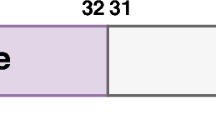Abstract
This article presents SPLASH, an algorithm that can sensitize several independent bitpaths simultaneously. SPLASH includes several new concepts and techniques aiming at a significant improvement and acceleration of the path sensitization for testing embedded modules in combinational and synchronous sequential circuits. The transparent paths are used to apply module test patterns through circuit inputs and observe the responses at circuit outputs. It consequently automates an important task of modular test generation, supplying a test pattern assembly program with a specification how to transform module test patterns into circuit level pattern.
A number of experiments using combinational and sequential benchmark circuits as well as industrial designs demonstrate the efficiency of the approach.
Similar content being viewed by others
References
M.S. Abadir and M.A. Breuer, “A Knowlegde-Based System for Designing Testable Chips,”IEEE Design & Test of Computers, Vol. 2, pp. 56–86, August 1985.
M.S. Abadir and H.K. Reghbati, “Functional Testing of Semiconductor Random Access Memories,”ACM Computing Surveys, Vol. 15, No. 3, pp. 175–198, September 1983.
M. Abramovici, M.A. Breuer, and A.D. Friedman,Digital Systems Testing and Testable Design, Computer Science Press, 1990.
G. Alfs, R.W. Hartenstein, and A. Wodko, “The KARL/KARATE System-Automatic Test Pattern Generation Based on RT Level Descriptions,”Proc. Int. Test Conf., pp. 230–235, 1988.
B. Becker, “An Easily Testable Optimal-Time VLSI Multiplier,”Proc. Euromicro, pp. 401–409, 1985.
C. Benmehrez and J.F. McDonald, “The Subscripted D-Algorithm-ATPG with Multiple Independent Control Paths,”Proc. IEEE Autom. Test Program Gener. Workshop, pp. 71–81, March 1983.
D. Bhattacharya and J.P. Hayes, “A Hierarchical Test Generation Methodology for Digital Circuits,”Jour. Electronic Testing: Theory and Applic., Vol. 1, pp. 103–123, May 1990.
F. Brglez, D. Bryan, and K. Kozminski, “Combinational Profiles of Sequential Benchmark Circuits,”Proc. IEEE Int. Symp. on Circuits and Systems, pp. 1929–1934, 1989.
F. Brglez and H. Fujiwara, “A Neutral Netlist of 10 Combinational Benchmark Circuits and a Target Translator in FORTRAN,”Proc. IEEE Int. Symp. on Circuits and Systems, June 1985.
W.-T. Cheng and T.J. Chakraborty, “Gentest—An Automatic Test-Generation System for Sequential Circuits,”Computer, Vol. 22, pp. 43–49, April 1989.
S. Freeman, “Test Generation for Data-Path Logic: The F-Path Method,”IEEE Journal of Solid-State Circuits, Vol. 23, No. 2, pp. 421–427, April 1988.
H. Fujiwara and T. Shimono, “On the Acceleration of Test Generation Algorithms,”IEEE Trans. on Computers, Vol. C-32, pp. 1137–1144, December 1983.
P. Goel, “An Implicit Enumeration Algorithm to Generate Tests for Combinational Logic Circuits,”IEEE Trans. on Computers, Vol. C-30, pp. 215–222, March 1981.
N. Gouders and R. Kaibel, “Advanced Techniquer for Sequential Test Generation,”Proc. Europ. Test Conf., pp. 293–300, 1991.
B. Hanstein, M. Johansson, W. Roth, and F. Dymann, “Modular Testing of a VLSI Processor Chip Using the BED System,”Proc. Europ. Test Conf., p. 490, 1991.
M. Karam, R. Leveugle, and G. Saucier, “Hierarchical Test Generation Based on Delayed Propagation,”Proc. Int. Test Conf., pp. 739–747, 1991.
G. Krüger, “A Tool for Hierarchical Test Generation,”Proc. Int. Conf. on Computer-Aided Design, pp. 420–423, 1988.
M. Marhöfer, “Fehlerdiagnose für Schaltnetze aus Modulen mit partiell injektiven Pfadfunktionen,” Springer Verlag, Informatik-Fachberichte 139.
B.T. Murray and J.P. Hayes, “Hierarchical Test Generation Using Precomputed Tests for Modules,”Proc. Int. Test Conf., pp. 221–229, 1988.
J. Rajski and H. Cox, “A Method to Calculate Necessary Assignments in Algorithmic Test Pattern Generation,”Proc. Int. Test Conf., pp. 25–34, 1990.
J.P. Roth, “Diagnosis of automata failures: a calculus and a method,”IBM J. Research and Development, pp. 278–291, July 1966.
W. Roth, M. Johansson, and W. Glunz “The BED Concept—A Method and a Language for Modular Test Generation,”Proc. Int. Conf. on VLSI, pp. 143–152, 1989.
M. Schulz, E. Trischler, and T. Sarfert, “SOCRATES: A Highly Efficient Automatic Test Pattern Generation System,”Proc. Int. Test Conf., pp. 1016–1026, 1987.
C.-C. Su and C.R. Kime, “Multiple Path Sensitization for Hierarchical Circuit Testing,”Proc. Int. Test Conf., pp. 152–161, 1990.
E. Trischler and M. Johansson, “The TEN Concurrent Test Engineering Environment: An Overview,” to be published in theIEEE Design and Test of Computers.
Author information
Authors and Affiliations
Rights and permissions
About this article
Cite this article
Keutner, K., Trischler, E. Efficient sensitization of multi-bit-paths for testing embedded modules in synchronous sequential circuits. J Electron Test 6, 45–58 (1995). https://doi.org/10.1007/BF00993129
Received:
Revised:
Issue Date:
DOI: https://doi.org/10.1007/BF00993129




